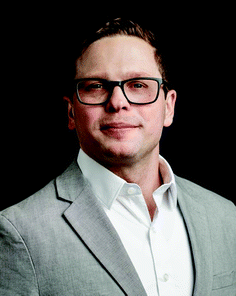Materials Horizons Emerging Investigator Series: Prof. Dr Thomas Schutzius, ETH Zurich, Switzerland
Dr Thomas Schutzius is an Assistant Professor at ETH Zurich, where he leads the Laboratory for Multiphase Thermofluidics and Surface Nanoengineering (MTSN, https://mtsn.ethz.ch/). His research intersects the multidisciplinary fields of energy, surface science and engineering, and thermofluidics, and his experimental work captures the fundamental dynamics of a vast array of interfacial and micro-nanoscale transport phenomena. Dr Schutzius is a recipient of the prestigious ERC Starting Grant, which supports his research on understanding the fundamentals of limescale formation on surfaces (scaling) and using this knowledge to rationally engineer “scale-phobic” surfaces. In 2020, he received the ETH “Golden Owl” award (https://ethz.ch/en/the-eth-zurich/education/awards/golden-owl.html) for excellent teaching and was a nominee for the KITE Award 2022 (https://ethz.ch/en/the-eth-zurich/education/innovation/kite-award.html) recognizing innovation in teaching. During his graduate studies, he was the recipient of the Dean's Scholar Award and the UIC Outstanding Thesis Award. He also received the ETH Zurich Postdoctoral Fellowship. In 2018, he was part of the ETH Zurich representation to the prestigious Global Young Scientist Summit (GYSS) in Singapore.
Read Thomas Schutzius's Emerging Investigator Series article ‘Microscale investigation on interfacial slippage and detachment of ice from soft materials’ (10.1039/D1MH01993G) and read more about him in the interview below:
MH: Your recent Materials Horizons Communication studies dynamic ice-elastomer interfacial events and shows that the ice adhesion strength can vary due to the shear velocity. How has your research evolved from your first article to this most recent article and where do you see your research going in future?
TS: When I started out, I was working on lotus-like surfaces made from polymer composites, which were very repellent to water, and I found that fascinating. At the time, the challenge was making durable materials so that this impressive property could be used in real applications. So, the focus was not really on the mechanisms of what was going on, but I was very curious. Since then, my research has focused primarily on mechanisms, especially repellency, but we’ve moved towards repelling more complex things such as ice and limescale, which involve phase change or precipitation. We would like to use what we learn there to make new coatings for water and energy applications. Along the way, we sometimes develop new methods or take a method from one domain and apply it in another. That was the case in this paper with confocal traction force microscopy, which is normally used in mechanobiology. We used it to study ice adhesion to surfaces.
MH: What aspect of your work are you most excited about at the moment?
TS: We are very excited about limescale! It's unsightly in our coffee pots at home, but it's a terrible problem in heat exchangers and membranes that use cooling water that is “hard” (contains minerals). This greatly impacts how we produce our energy and treat our water. So, we are very interested to dig into the microscale phenomena of how these limescale layers form.
MH: In your opinion, what are the most important questions to be asked/answered in this field of research?
TS: I won’t phrase it as a question, but I think we need to study basic thermodynamic processes—which are usually well-understood at macroscopic scales—at small scales and near new or interesting materials. We should look for phenomena that surprise us there. I like what L. Pasteur supposedly said on this: in experimental work, chance favors the prepared mind. We should have a preconception based on macroscopic observations and intuition, but be on the look out for when the behavior departs from that. Many interesting questions will emerge then.
MH: What do you find most challenging about your research?
TS: Nucleation. It's stochastic process and sensitive to everything. It keeps me up at night.
MH: In which upcoming conferences or events may our readers meet you?
TS: For sure I will be at the World Conference on Experimental Heat Transfer, Fluid Mechanics and Thermodynamics (https://www.exhft-10.gr/) from Aug 22–26, 2022 and the Gordon Research Conference on Micro and Nanoscale Phase Change Phenomena (https://www.grc.org/micro-and-nanoscale-phase-change-phenomena-conference/2023/) from Jan 8–13, 2023.
MH: How do you spend your spare time?
TS: Chasing after my toddler and newly crawling baby.
MH: Can you share one piece of career-related advice or wisdom with other early career scientists?
TS: Maybe more practical, but junior scientists tend to get a lot of feedback—which is good because it means science is functioning and that people care—but sometimes it can be unnecessarily negative. If you can use the feedback, great, do it. If not, block it out and move on.
| This journal is © The Royal Society of Chemistry 2022 |

